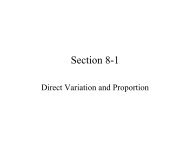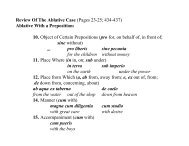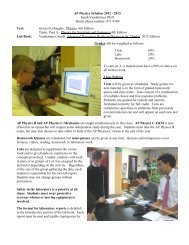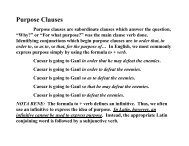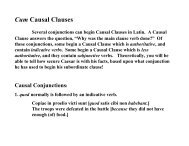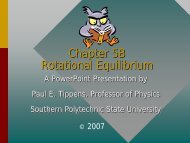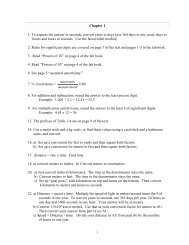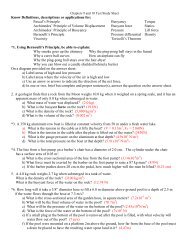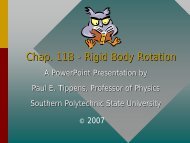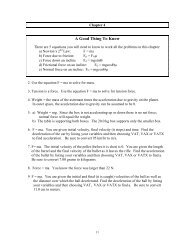Light and Illumination
Light and Illumination
Light and Illumination
Create successful ePaper yourself
Turn your PDF publications into a flip-book with our unique Google optimized e-Paper software.
Chapter 33 - <strong>Light</strong> <strong>and</strong><strong>Illumination</strong>A PowerPoint Presentation byPaul E. Tippens, Professor of PhysicsSouthern Polytechnic State University© 2007
Objectives: After completing thismodule, you should be able to:• Define light, , discuss its properties, <strong>and</strong> givethe range of wavelengths for visible spectrum.• Apply the relationship between frequencies<strong>and</strong> wavelengths for optical waves.• Define <strong>and</strong> apply the concepts of luminousflux, luminous intensity, , <strong>and</strong> illumination.• Solve problems similar to those presented inthis module.
A Beginning DefinitionAll objects are emitting<strong>and</strong> absorbing EM radia-tion. . Consider a pokerplaced in a fire.As heating occurs, theemitted EM waves havehigher energy <strong>and</strong>eventually become visible.First red . . . then white.1234<strong>Light</strong> may be defined as electromagnetic radiationthat is is capable of of affecting the sense of of sight.
Electromagnetic WavesElectric EMagnetic BBEc3 x 10 8 m/sWave Properties:1. Waves travel at thespeed of light c.2. Perpendicular electric<strong>and</strong> magnetic fields.3. Require no mediumfor propagation.For a complete review of of the electromagneticproperties, you should study module 32C.
The Wavelengths of <strong>Light</strong>The electromagnetic spectrum spreads over atremendous range of of frequencies or or wavelengths.The wavelength is is related to to the frequency f: f:c = fc = 3 x 10 8 m/sThose EM waves that are visible (light) have wave-lengths that range from 0.00004 to 0.00007 cm.Red, 0.00007 cmViolet, 0.00004 cm
Frequency wavelengthf (Hz) nm)10 2410 2310 2210 2110 2010 1910 1810 1710 1610 1510 1410 1310 1210 1110 1010 910 810 710 610 510 4Gamma raysX-raysUltravioletInfrared raysShort RadiowavesBroadcast RadioLong Radiowaves10 -710 -610 -410 -310 -111010 210 310 410 510 610 710 810 910 1010 1110 1210 13The EM SpectrumA wavelength of onenanometer 1 nm is:1 nm = 1 x 10 -9 -9 mVisible Spectrum400 nm 700 nmRed 700 nm Violet 400 nmc = fc = 3 x 10 8 m/s
Example 1. <strong>Light</strong> from a Helium-Neon laserhas a wavelength of 632 nm. . What is thefrequency of this wave?The Helium Neon LaserLaserWavelength = 632 nmcc ff 83 x 10 m/s-9632 x 10 mf f = 4.75 x 10 14 14 HzRed light
Properties of <strong>Light</strong>Any study of of the nature of of light mustexplain the following observed properties:• Rectilinear propagation: <strong>Light</strong> travels instraight lines.• Reflection: <strong>Light</strong> striking a smooth surfaceturns back into the original medium.• Refraction: <strong>Light</strong> bends when entering atransparent medium.
The Nature of <strong>Light</strong>Physicists have studied light for centuries, findingthat it it sometimes behaves as a particle <strong>and</strong>sometimes as a wave. Actually, both are correct!Reflection <strong>and</strong>rectilinear propagation(straight line path)Dispersion of whitelight into colors.
Photons <strong>and</strong> <strong>Light</strong> Rays<strong>Light</strong> may be thought of as little bundles of wavesemitted in discrete packets called photons.The wave treatment uses rays to showthe direction of advancing wave fronts.photons<strong>Light</strong>ray<strong>Light</strong> rays areconvenient fordescribing howlight behaves.
<strong>Light</strong> Rays <strong>and</strong> ShadowsA geometric analysis may be made of shadowsby tracing light rays from a point light source:PointsourceshadowscreenThe dimensions of of the shadow can be foundby using geometry <strong>and</strong> known distances.
Example 2: The diameter of the ball is 4 cm<strong>and</strong> it is located 20 cm from the point lightsource. If the screen is 80 cm from thesource, what is the diameter of the shadow?h80cm20 cm4cm20cm4 cm80 cmhThe ratio ofofshadow totothe sourceis is same asthat of of ballto to source.Therefore:h (4 cm)(80 cm)20 cmh = 16 cm
Shadows of Extended ObjectsExtendedsourcepenumbraumbraThe • The umbra umbra is the is the region region where where no light no lightreachesthe reaches screen.the screen.• The penumbra is the outer area whereonly part of the light reaches the screen.
The Sensitivity CurveHuman eyes are notequally sensitive toall colors.Eyes are most sensi-tive in the mid-rangenear = = 555 nm.SensitivitySensitivity curve555 nm400 nm 700 nmWavelength 40 W 40 WYellow light appears brighterto to the eye than does red light.
Luminous FluxLuminous flux is the portion of total radiant powerthat is capable of affecting the sense of sight.Typically only about 10%of the power (flux) emittedfrom a light bulb falls inthe visible region.The unit for luminous flux is the lumen whichwill be given a quantitative definition later.
A Solid Angle: SteradiansWorking with luminous flux requires the use of of asolid angle measure called the steradian (sr).A solid angle of of onesteradian (1 sr) ) isissubtended at at thecenter of of a sphereby an area A equalto to the square of of itsradius ( R 22 ).).RARTheSteradian 2A
Example 3. What solid angle is subtended atthe center of a sphere by an area of 1.6 m 2 ?The radius of the sphere is 5 m. mR5 mA1.6 m 2ARTheSteradian 2AR221.60 m(5.00 m) = 0.00640 sr sr2
The Lumen as a Unit of FluxOne lumen (lm) is the luminous flux emitted froma 1/60 cm 2 opening in a st<strong>and</strong>ard source <strong>and</strong>included in a solid angle of one steradian (1 sr).In practice, sources of light are usually ratedby comparison to a commercially preparedst<strong>and</strong>ard light source.A typical 100-W inc<strong>and</strong>escentlight bulb emits a total radiantpower of about 1750 lm. . This isfor light emitted in all directions.
The Lumen in Power UnitsRecalling that luminous flux is really radiantpower allows us to define the lumen as follows:One lumen is is equal to to 1/680 W of of yellow-green light of of wavelength 555 nm.A disadvantage of thisapproach is the need torefer to sensitivity curvesto determine the flux fordifferent colors of light.Sensitivity curveWavelength
Luminous IntensityThe luminous intensity I for a light sourceis the luminous flux per unit solid angle.FI Luminous intensity:FI Unit is the c<strong>and</strong>ela (cd)A source having an intensity of of one c<strong>and</strong>elaemits a flux of of one lumen per steradian.
Total flux for Isotropic SourceAn isotropic source emits inall directions; i.e., over asolid angle of 4 steradians.= = 44srThus, for suchFa source, theI intensity is: 4Total flux: F = 4IThe flux confined to area A is:F = I AFR3 m
Example 4. A 30 cd spotlight is located 3 mabove a table. The beam is focused on a surfacearea of 0.4 m 2 . Find the intensity of the beam.Total flux: F = 4IF T = 4(304cd) ) = 377 lm RThe luminous intensity ofthe beam depends on 20.4 m2 2 ; 0.0444 srA R (3 m)I F754 lm0.0444 sr3 mBeam Intensity:I = 8490 cd
<strong>Illumination</strong> of a SurfaceThe illumination Eof a surface Ais defined asthe luminous flux per unit area (F/A) () in in lumensper square meter which is is renamed a lux (lx).An illumination of of one luxoccurs when a flux of ofone lumen falls on anarea of of one squaremeter.FE Unit: lux (lx)A<strong>Illumination</strong>, EArea AR
<strong>Illumination</strong> Based on IntensityThe illumination E of of a surface is is directlyproportional to to the intensity II <strong>and</strong> inverselyproportional to to the square of of the distance R. RF FE ; I ; F IA IAE but so that2AR<strong>Illumination</strong>,EIR2Area ARThis equation applies forperpendicular surfaces.
Example 5. A 400-cdlight is located 2.4 mfrom a tabletop of area 1.2 m 2 . What is theillumination <strong>and</strong> what flux F falls on the table?E IR400 cd(2.40 m)2 2R<strong>Illumination</strong>:E = 69.4 lxNow, recalling that E = F/A, , we find F from:F = EA = (69.4 lx)(1.20 m 2 ) F = 93.3 lm
The Inverse Square RelationshipEIR2E1 mE/9E/41 m 2 4 m 2 9 m 23 m2 mIf the intensity is 36 lx at 1 m, it willbe 9 lx at 2 m <strong>and</strong> only 4 lx at 3 m.
Summary<strong>Light</strong> may be defined as electromagnetic radiationthat is is capable of of affecting the sense of of sight.General Properties of <strong>Light</strong>:• Rectilinear propagation• Reflectionc• Refraction= fc = 3 x 10 8 m/sRed, 700 nmViolet, 400 nm
Summary (Continued)The formation of shadows:ExtendedsourcepenumbraumbraLuminous flux is the portion of total radiant powerthat is capable of affecting the sense of sight.
Summary (Continued)RARTheSteradian 2ATotal flux: F = 4ILuminous intensity:FI Unit is the c<strong>and</strong>ela (cd)EFAUnit: lux (lx)
Summary (Cont.)<strong>Illumination</strong>,EIR2<strong>Illumination</strong>, E9 m 23 mE/9E/44 m 21 m 22 m 1 mEArea AR
CONCLUSION: Chapter 33<strong>Light</strong> <strong>and</strong> <strong>Illumination</strong>




